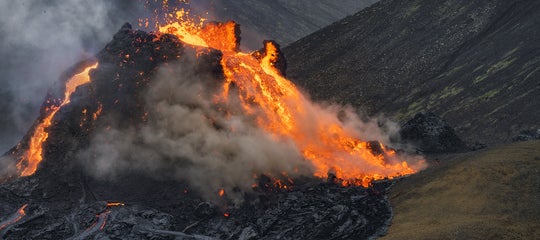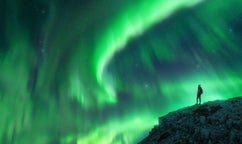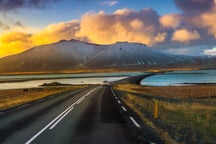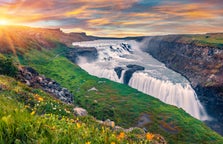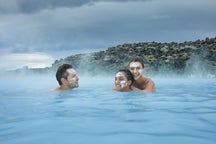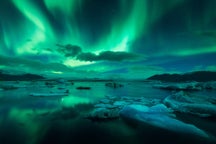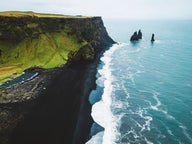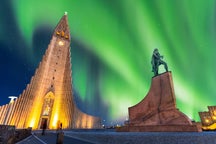
Located in the southwest of Iceland, the Reykjanes peninsula is a fascinating region known for its rugged landscapes. Located on the Mid-Atlantic Ridge, Reykjanes is filled with volcanic and geothermal activity, as recently made famous by the eruptions in Fagradalsfjall volcano, Litli-Hrutur mountain, the Hagafell mountain, and the Sundhnukagigar crater row just outside Grindavik.
Surrounded by breathtaking seascapes, Reykjanes has a rich history of seafaring, where brave sailors faced rough seas for centuries. The region also served an important role in World War II when the US military operated a base in the town of Keflavik (which is also the fountainhead for Icelandic rock music). Staying at one of the best hotels near Keflavik airport is a great way to soak in the culture and history of the peninsula.
Why You Can Trust Our Content
Guide to Iceland is the most trusted travel platform in Iceland, helping millions of visitors each year. All our content is written and reviewed by local experts who are deeply familiar with Iceland. You can count on us for accurate, up-to-date, and trustworthy travel advice.
Often overlooked, Reykjanes allows you to take a soothing dip in a relaxing hot spring and view stunning landscapes created by volcanic eruptions and geothermal activity on the same day. Whether you decide to explore the area as part of a self-drive tour or on one of a number of intriguing Reykjanes tours available, don't miss out on the harsh beauty of the Reykjanes.
- Reykjanes is on the list of the Best Things to Do Near Reykjavik
Why You Should Visit Reykjanes Peninsula
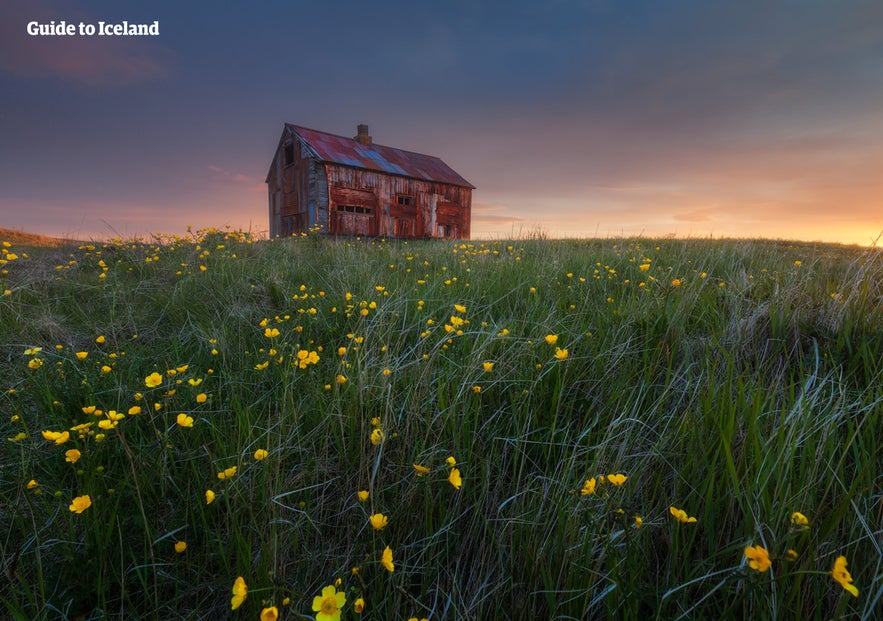 Reykjanes garnered international attention in recent years with stunning imagery showcasing the incredible volcanic eruptions in Geldingadalur valley. Thousands of people from all over the globe flocked to Iceland to witness the jaw-dropping phenomena, leaving one to wonder why the Reykjanes peninsula isn't more popular.
Reykjanes garnered international attention in recent years with stunning imagery showcasing the incredible volcanic eruptions in Geldingadalur valley. Thousands of people from all over the globe flocked to Iceland to witness the jaw-dropping phenomena, leaving one to wonder why the Reykjanes peninsula isn't more popular.
Iceland is brimful of exciting attractions, and with the Golden Circle and the Jokulsarlon glacier lagoon at the top of the to-do list for many travelers, the Reykjanes peninsula is often overlooked. This can work to your benefit, however, as the area is less crowded, and nature lovers can take in the raw grandeur of the region without as many distractions.
The Reykjanes peninsula is also conveniently located, with many of the sites within an hour's driving distance from the capital of Reykjavik. If you are arriving in Iceland at Keflavik airport, you are already on the Reykjanes peninsula and can easily take a detour to see the sights on the way to the city. If you are staying at a Keflavik hotel, consider renting a car in Keflavik Airport to explore your surroundings.
How to Get to Reykjanes Peninsula
The drive to Reykjanes peninsula from the capital is approximately 31 miles (50 kilometers) via Reykjanesbraut road (R41). A great way to explore the area is by renting a car, but some of the sites in the region are accessible through gravel roads, where renting a four-wheel drive will be necessary.
Another way to explore Reykjanes is as a part of one of the excellent guided tours operated in the area. You could take a dip in the Blue Lagoon after exploring the stunning landscapes on a small group 6-hour tour of Reykjanes with Blue Lagoon or Keflavik options. Another great way to tackle the peninsula is on an adventurous ATV tour of the Reykjanes Lava Fields.
11 Natural Wonders in Reykjanes Peninsula
The rugged and dramatic scenery at Reykjanes peninsula is unlike that found anywhere else in Iceland. The harsh seas, moss-covered lava fields, and steam-filled air all combine to create this unique region. Here is a list of some of our favorite natural wonders in the Reykjanes peninsula.
11. Hafnarberg Sea Cliffs
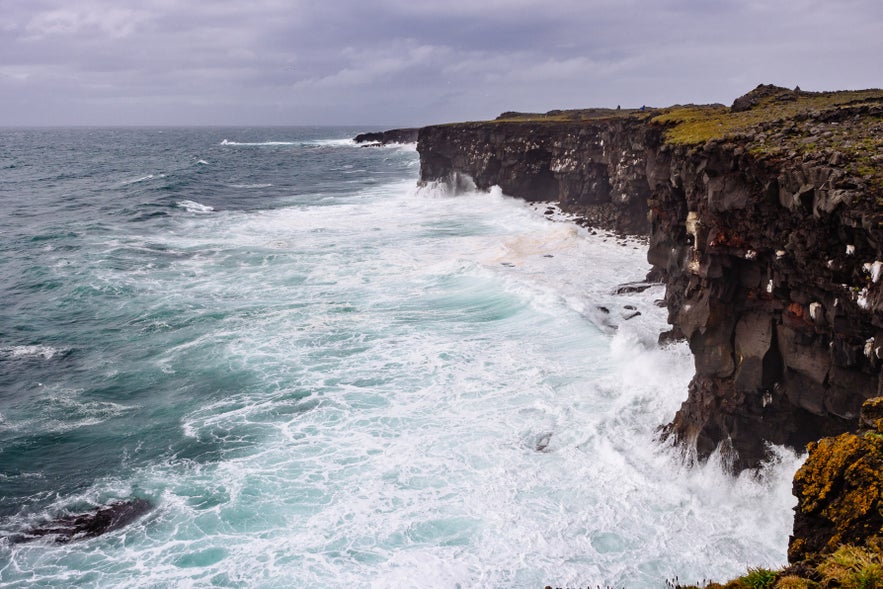 Located near the fishing village of Hafnir are the Hafnarberg sea cliffs, offering dramatic views over the turbulent sea of the western end of the Reykjanes peninsula. They are known for their jagged volcanic formations and birdlife.
Located near the fishing village of Hafnir are the Hafnarberg sea cliffs, offering dramatic views over the turbulent sea of the western end of the Reykjanes peninsula. They are known for their jagged volcanic formations and birdlife.
A popular spot for hikers and bird watchers alike, the cliffs can conveniently be found a short distance from a nearby parking lot. Standing atop the Hafnarberg sea cliffs and staring at the often violent seas can offer a humbling insight into the dangers the sailors in the area faced for centuries.
10. Reykjanesta and Eldey
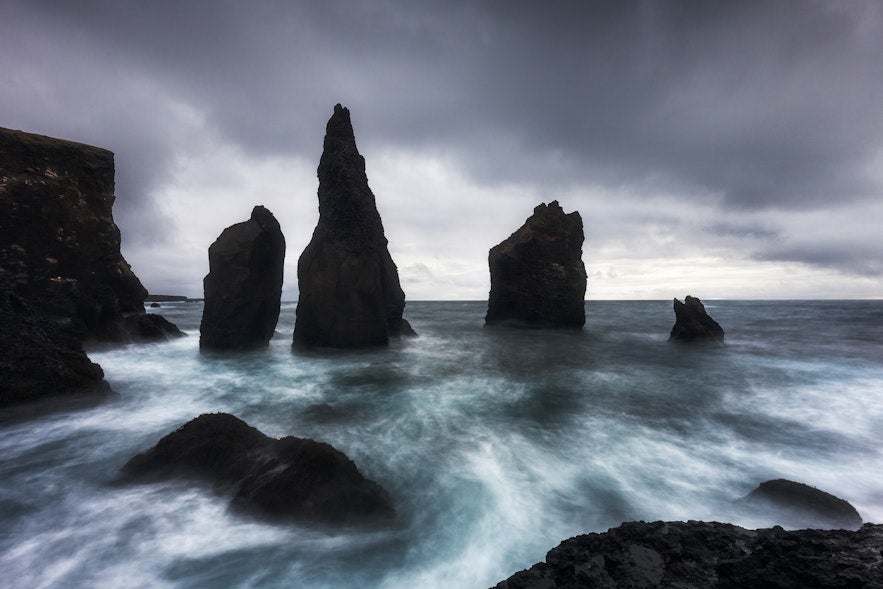
Reykjanesta is the name of the southwestern tip of the Reykjanes peninsula, another scenic location full of jagged rock and thriving birdlife and a great place to take memorable pictures.
The area has plenty to see, including the cliff of Valahnukur, which offers a great vantage point of the harsh but beautiful landscape and the accompanying boulder ridge of Valahnukamol and the ever-vigilant Reykjanesviti lighthouse.
From Reykjanesta, you can see the isle of Eldey in the distance, towering above the waves. Eldey has a close connection with an interesting statue in the area dedicated to the last great auk, a species of large birds once native to Iceland. The last known pair of great auks were hunted in Eldey in the 19th century, rendering the species extinct.
9. Krysuvik Geothermal Area
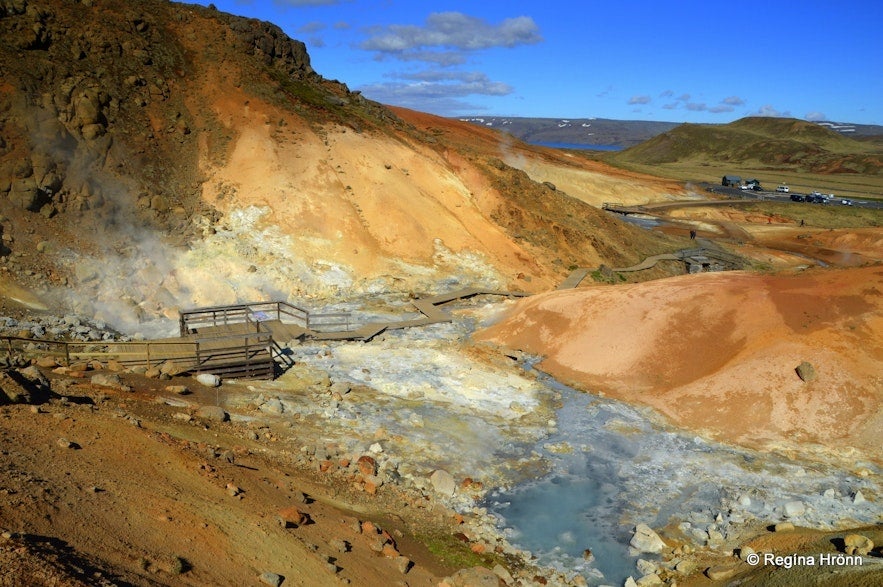
The Krysuvik Geothermal Area is a great demonstration of the geological diversity found on the Reykjanes peninsula. A popular attraction for locals as well as tourists, it is known for its accessibility, with wooden pathways and viewing platforms guiding visitors along the way.
As you enter the Krysuvik geothermal area, you will immediately be greeted with the smell of sulfur, which is a good indicator of things to come. Entering this captivating site is like stepping onto another planet, full of hot springs, steaming vents, bubbling mud pots, and fumaroles.
The manifestations of these geothermal powers are plainly visible in the vivid color patterns adorning the rocks in the area, making it a fantastic spot to explore as part of a small group 6-hour tour of Reykjanes. Remember that straying from the wooden pathways can be very dangerous and even life-threatening.
8. The Bridge Between Continents
 If you have ever dreamt of walking between America and Europe, make sure to check out The Bridge Between Continents. Located between the North American and Eurasian tectonic plates, the bridge stands as a symbol of the connection between the continents.
If you have ever dreamt of walking between America and Europe, make sure to check out The Bridge Between Continents. Located between the North American and Eurasian tectonic plates, the bridge stands as a symbol of the connection between the continents.
Iceland is uniquely located atop the Mid-Atlantic Ridge, the boundary between the tectonic plates, meaning that parts of the country are technically in America, with others being in Europe. Iceland is one of the few places where the Mid-Atlantic Ridge is visible above sea level, with the Bridge Between Continents being one of the best examples.
While there is not much to do in the area surrounding the bridge apart from taking in the geology and symbolism, it remains a great spot to get memorable photos (try 'holding' the bridge while standing in the crevice below) and a nice brag to share with people at cocktail parties.
7. Brimketill Lava Rock Pool
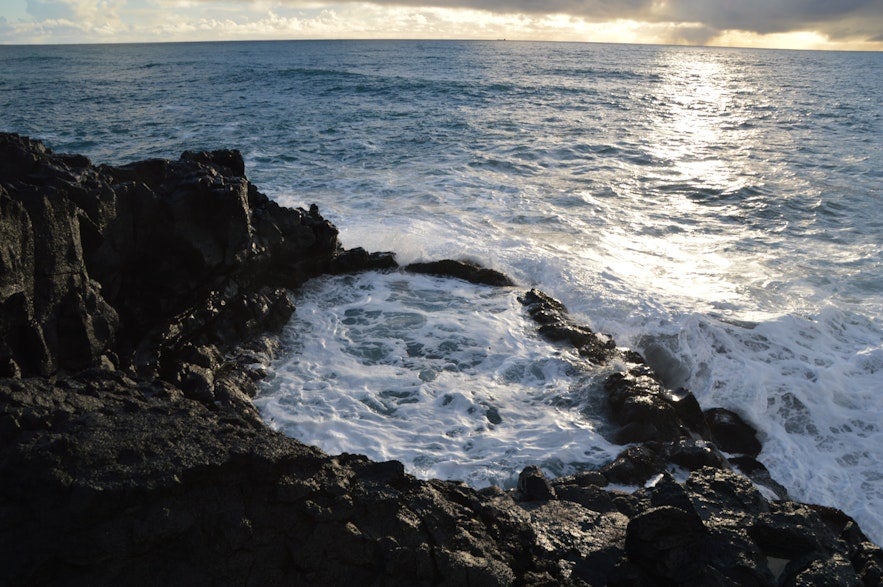 Brimketill is a lava rock pool formed by the erosion of the powerful tides surrounding it. Its name, which translates to 'Whitewater cauldron,' is easily understood when viewing Brimketill from above as the waves come crashing in, refilling it with seawater.
Brimketill is a lava rock pool formed by the erosion of the powerful tides surrounding it. Its name, which translates to 'Whitewater cauldron,' is easily understood when viewing Brimketill from above as the waves come crashing in, refilling it with seawater.
Steeped in folklore, Brimketill has also gone by the name Oddnyjarlaug, named after a giantess who is said to have used the pool for bathing and washing her clothes. Although Brimketill is vaguely shaped like a jacuzzi, you should leave the bathing to the trolls as the water is extremely cold, and the coarse and slippery rocks are a disaster waiting to happen.
Thankfully, the view of Brimketill is accessible from a nearby viewing platform, allowing you to marvel at the waves filling this unique cauldron with the frothing ocean from a safe distance.
- Read more: Brimketill on the Reykjanes Peninsula
6. Gunnuhver Geothermal Area

Photo from Wikimedia, Creative Commons, by Jakub Hałun. No edits made.
Gunnuhver is another geothermal area you shouldn't miss when visiting Reykjanes, and it is luckily hard to miss, thanks to the large strokes of steam emanating from the hot springs located there. Another staple attraction of the region, it combines intriguing folklore with its exquisite scenery.
Named after a vengeful ghost by the name of Gunna, who some say can be spotted through the mists in the area, Gunnuhver can be beautifully haunting as the steam clouds engulf travelers making their way through the trails of the area.
Apart from its unique atmosphere, Gunnuhver has a number of things to see, including Iceland's largest mud pool which bubbles with an impressive width of 65 feet (20 meters). A memorable way of exploring this steamy wonderland is on an exhilarating 6-hour ATV day tour and volcano safari.
5. Raufarholshellir Lava Tunnel

Photo from Incredible 1-Hour Lava Tunnel Tour at Raufarholshellir Cave with Transfer from Reykjavik.
Raufarholshellir is one of the longest and most accessible lava tubes in Iceland, stretching for an impressive 4,461 feet (1,360 meters). Formed by a volcanic eruption, it allows offers visitors a chance for a subterranean adventure with a glimpse into Iceland's volcanic past.
With various geological formations, including stalactites, stalagmites, and intricate patterns on the cave walls created by flowing lava, visitors will naturally be drawn to explore deeper and deeper into Raufarholshellir. Thankfully, it might just be Iceland's most accessible cave, with lighting and walkways to guide you through its wonders.
With knowledgeable guides on site to illuminate visitors (and the cave itself, with artificial lighting), a great way to get to know the cave is on a guided 1-hour lava tunnel exploration tour. Those wishing to delve deeper into the depths might consider a magnificent 3-hour caving tour of Raufarholshellir Lava Tunnel.
4. Lake Kleifarvatn
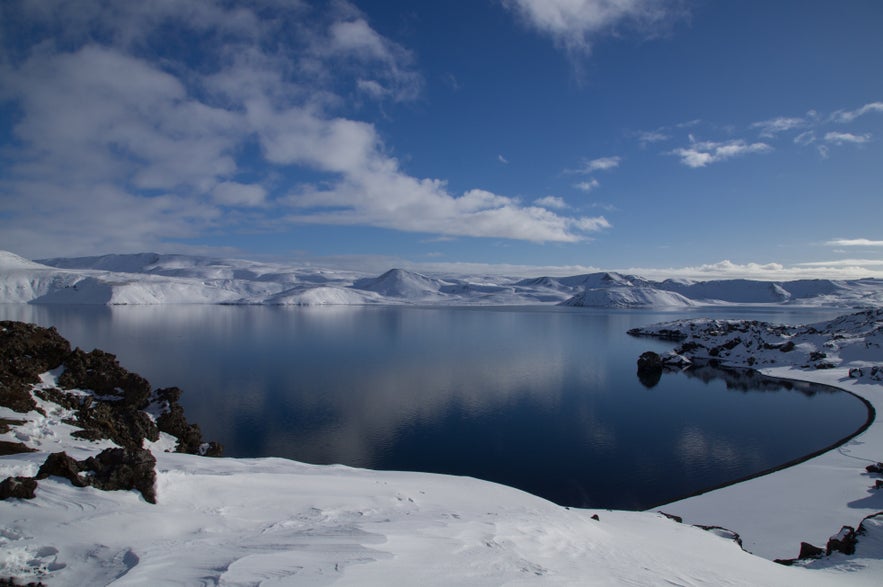 Kleifarvatn is the largest lake on the Reykjanes peninsula and one of the region's primary attractions, with its beautiful and serene waters acting as a welcome contrast to its harsh surroundings. The lake covers around 3.5 square miles (9.1 square kilometers) and is one of Iceland's deepest lakes, with a depth of 318 feet (97 meters).
Kleifarvatn is the largest lake on the Reykjanes peninsula and one of the region's primary attractions, with its beautiful and serene waters acting as a welcome contrast to its harsh surroundings. The lake covers around 3.5 square miles (9.1 square kilometers) and is one of Iceland's deepest lakes, with a depth of 318 feet (97 meters).
In the year 2000, an earthquake below Kleifarvatn created a fissure that drained over a fifth of its surface area. The lake has somewhat recovered since then, but not fully. Kleifarvatn is not fed by any rivers; all the water coming in and out of it comes from the porous lava rock around it.
Popular with hikers and photographers, Kleifarvatn is also rich in wildlife, with ducks and swans being a common sight on its waters. Local myths have also told of a mysterious serpent-like creature dwelling in the lake, but we wouldn't recommend waiting around for it to pop up.
3. The Blue Lagoon

The Blue Lagoon is by far the most popular attraction in the Reykjanes peninsula, attracting people from all over the globe to bathe in its milky blue waters.
This hot spring and geothermal spa has an interesting history, but the Blue Lagoon started when runoff water from Svartsengi Power Station began to collect in a pool in 1976. The pool grew over time, and a few years later, people started to bathe in it and were surprised by the healing qualities of the water.
Years later, the Blue Lagoon has grown into a hot spring empire of worldwide renown. Featuring a hotel, multiple restaurants, cafes, massage areas, and a gift shop, it is Iceland's number one attraction.
With its comfortable waters and soothing atmosphere, it is no wonder that the Blue Lagoon is the most anticipated stop on a visit to Iceland for many travelers. This popularity, combined with a limited capacity, does, however, mean that it is vital to buy your ticket several months ahead to secure a spot.
There are multiple options available to tailor a visit to the Blue Lagoon to your needs, and if you want to go sightseeing on the same day, you can't go wrong with a Golden Circle & the Blue Lagoon Tour.
2. Sundhnukagigar, Litli-Hrutur, and Fagradalsfjall Eruption Sites
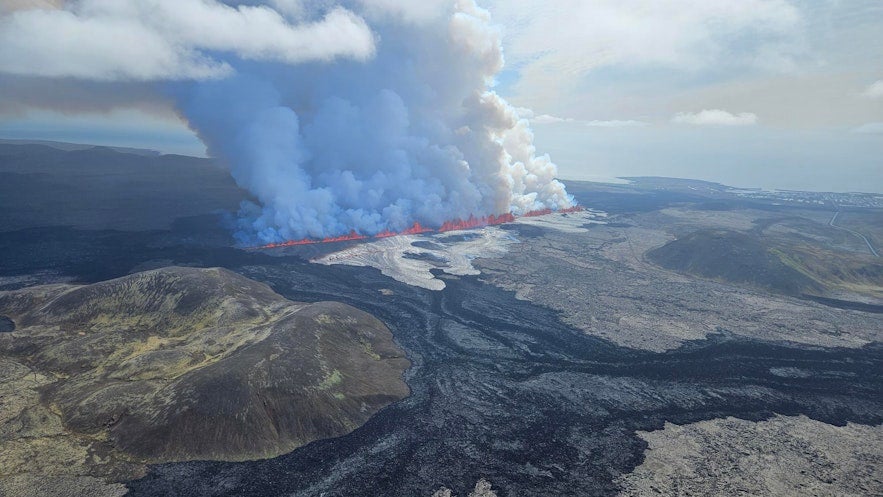
Photo from the May-June 2024 Sundhnukagigar eruption by Grindavik
The eruptions in Fagradalsfjall volcano in 2021 and 2022 garnered Iceland international attention, and tens of thousands of people rushed to witness the eruptions in an area that had lain dormant for over 800 years. As impressive as the eruption was, its sheltered location thankfully meant that Icelandic infrastructure was unharmed and this spectacular phenomenon could be enjoyed safely.
In 2023, a third eruption started in the area, this time at the roots of Litli-Hrútur mountain, which lasted for just under a month. Just a few months later, on December 18th, the Earth was ripped open again by the Sundhnukagigar crater row. Lava spewed up 328 feet (100 meters) in the air over a 2.5-mile (4-kilometer) long fissure, but it came to an end just a few days later, on December 21st. Since then, the area has experienced regular but short eruptions.
In July 2025, a new hiking path was opened, allowing visitors to get closer to the eruption site than ever before. You can find the most recent trail information on the VisitReykjanes website.
If you plan to hike on your own, it's a good idea to wear proper hiking gear. In some low areas, gas can build up, even when there’s no visible eruption.
For a safer and more comfortable experience, you might want to join a guided hiking tour to the volcano. This tour includes expert guides and the latest updates about conditions in the area. Be sure to check the Loftgæði website for air quality and the SafeTravel website for safety information.
In addition to hiking, a new shuttle service now runs to the volcano viewpoints. It’s a great option for those short on time or who prefer a more relaxed visit. If you want a more thrilling experience, take a helicopter tour that offers an incredible way to see the stunning lava fields from above. You can also learn more about the ongoing volcanic activity on the Reykjanes Peninsula with our complete guide to the Sundhnukagigar volcanic eruptions.
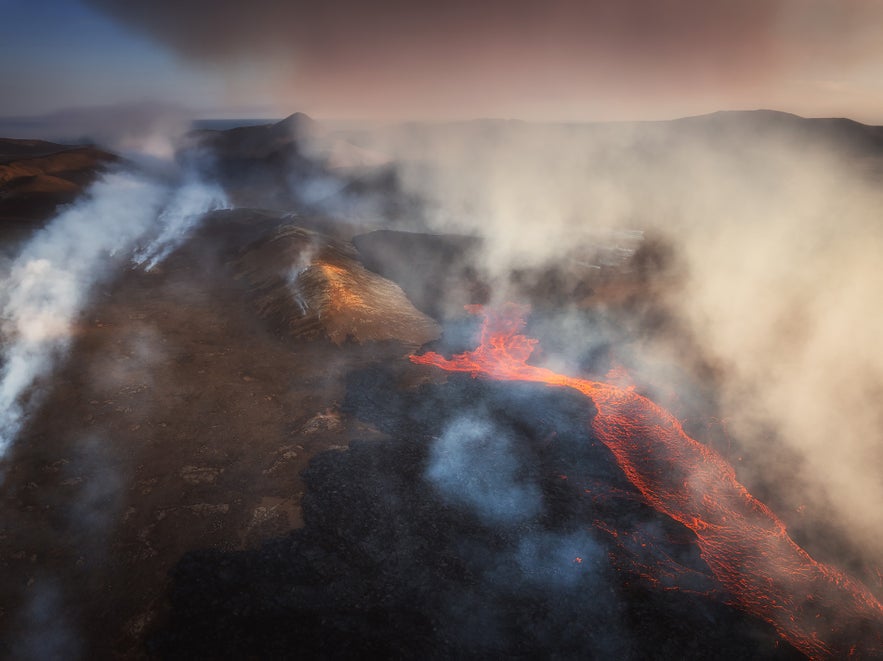
Photo from the 2023 Litli-Hrutur eruption
If it becomes possible to visit the eruption sites, you can take on the 12-mile (20-kilometer) round-trip hiking path to Litli-Hrutur. Most of the path is along a gravel road, but the terrain of the last part is very rough, so make sure to wear proper hiking boots and warm layered clothing. For optimal safety, join guided volcano tours.
You can also hike to the Fagradalsfjall volcano and see the stunning aftermath of the other two eruptions, which are slightly easier to reach. The newly formed lava field and craters that resulted from the eruptions are still a marvelous sight to behold.
- Learn more with the Complete Guide to the 2024-2025 Sundhnukagigar Volcanic Eruptions
- See also: Volcanic Eruptions on the Reykjanes Peninsula - A Complete Timeline (2021-2024)
- For more: Guide to the 2023 Eruption, the 2022 Eruption, and the 2021 Eruption of Fagradalsfjall
1. Thrihnukagigur Volcano
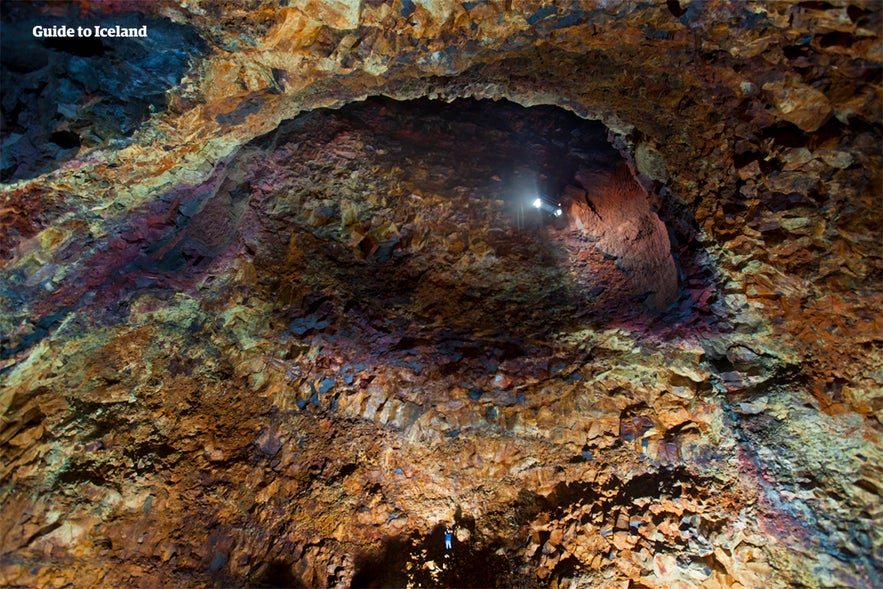 The dormant volcano of Thrihnukagigur is located roughly 20 miles (32 kilometers) from Reykjavik, although no roads lie directly up to it. While pretty enough to look at from the outside, it is the inside of Thrihnukagigur that really makes it a geological wonder, as it contains the only magma chamber in the world accessible to visitors.
The dormant volcano of Thrihnukagigur is located roughly 20 miles (32 kilometers) from Reykjavik, although no roads lie directly up to it. While pretty enough to look at from the outside, it is the inside of Thrihnukagigur that really makes it a geological wonder, as it contains the only magma chamber in the world accessible to visitors.
This extraordinary set of circumstances arose thousands of years ago with the volcano's last eruption. While a volcano will typically collapse in on itself after its magma chamber empties, a rift below Thrihnukagigur drained the remaining lava, leaving the volcano intact, as well as its colossal and now empty magma chamber.
Only being opened for visitors in 2012, travelers can now descend into the magma chamber of Thrihnukagigur in an elevator, journeying to the center of the earth in an adventure Jules Verne could have only dreamed of.
The scale of the chamber is astonishing, covering an area of 35,200 square feet (3,270 square meters) area, with a depth of 699 feet (213 meters). The interior walls of Thrihnukagigur exhibit a mesmerizing array of colors created by minerals and other natural elements that have transformed the volcanic rock over thousands of years.
Although seemingly daunting, the tours to Thrihnukagigur prioritize safety. Accessible between June and October, it is recommended that you book your tour well in advance to secure a spot in this amazing adventure. An unforgettable experience is to be had in an exceptional 2.5-hour Thrihnukagigur volcano tour with a helicopter ride.
Exploring Thrihnukagigur is a truly unique and once-in-a-lifetime experience that allows you to venture into the heart of a geological anomaly and witness the mesmerizing beauty hidden beneath the surface of the Earth.
7 Cultural Gems in Reykjanes Peninsula
With the beautiful natural wonders of the Reykjanes peninsula out of the way, it's important to note the culture that developed in their surroundings. Here are a few gems to get a better insight into the culture of Reykjanes, where the people have a reputation for taking on rough seas and rocking out when ashore.
7. Stekkjarkot Heritage Site
 Stekkjarkot is an old heritage site that features traditional Icelandic turf houses. While seemingly looking like something out of the works of J.R.R. Tolkien, these peculiar-looking buildings were the homes of Icelandic people well into the last century.
Stekkjarkot is an old heritage site that features traditional Icelandic turf houses. While seemingly looking like something out of the works of J.R.R. Tolkien, these peculiar-looking buildings were the homes of Icelandic people well into the last century.
Not a traditional farm, the people living in places such as Stekkjarkot could not keep any livestock and were thus very dependent on the sea for their livelihood. While a visit to Stekkjarkot is probably going to be a short one, it is a good photo stop and gives valuable insight into the humble lives of Icelandic people in ages past.
6. The Giantess Cave
 In a small cove by the marina in Keflavik lives a gentle giantess whose name has been forgotten. Sitting on a rocking chair within her humble abode, she gazes out over the bay and is always ready to welcome guests.
In a small cove by the marina in Keflavik lives a gentle giantess whose name has been forgotten. Sitting on a rocking chair within her humble abode, she gazes out over the bay and is always ready to welcome guests.
A character from a beloved Icelandic children's story, this tall statue of the giantess was placed in the cave in 2008 and has become a popular stop for families. Trolls in Icelandic folklore are usually not kindhearted, so this is a great chance for younger generations to meet one of the nicer ones up close.
- Read more: The gentle Giantess in the Cave in Keflavík
5. Selatangar Ruins
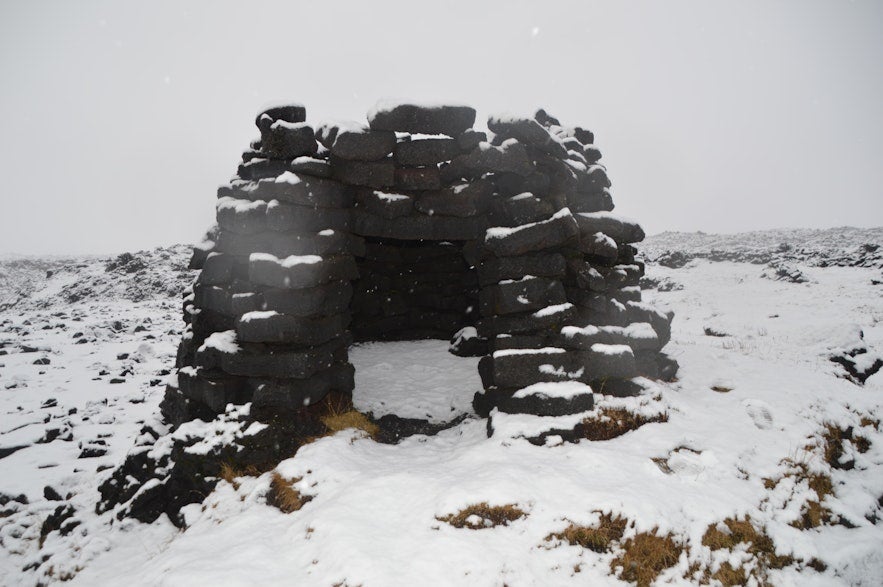 The ruins of the coastal fishing station Selatangar is an interesting site to explore when visiting Reykjanes. Throughout the centuries, Icelandic people built fishing stations to take to the sea, where life could often be quite difficult.
The ruins of the coastal fishing station Selatangar is an interesting site to explore when visiting Reykjanes. Throughout the centuries, Icelandic people built fishing stations to take to the sea, where life could often be quite difficult.
At Selatangar, you can find the foundations of huts and hovels that the sailors used to stay in and work the fish in. Walking around the area can give you an insight into how hard life could be there, as conditions on the peninsula can be very harsh.
- Read more: The Ruins at Selatangar
4. Icelandic Comfort Food in Reykjanes
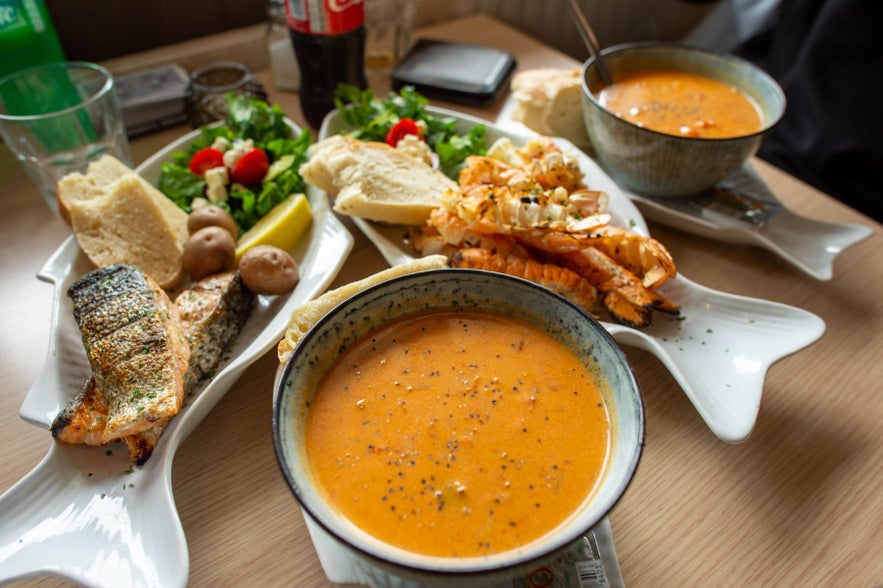 Reykjanes’ food culture reflects its rugged coastal landscape and fishing-village roots, offering hearty, comforting dishes that draw on the freshest local ingredients.
Reykjanes’ food culture reflects its rugged coastal landscape and fishing-village roots, offering hearty, comforting dishes that draw on the freshest local ingredients.
In towns like Keflavik, you’ll find cozy cafes serving rich soups and bread, family-run spots with fresh fish and seafood, and modern restaurants reinventing Icelandic classics like fish stew and lamb.
These local flavors are best enjoyed slowly, paired with craft beers, Brennivin, or a strong Icelandic coffee while soaking up the laid-back vibe of each town.
One popular spot is Brons in Keflavik, a bar-restaurant that has become a local favorite. It’s located just a short drive from Keflavik International Airport, in the main downtown area of Keflavik, making it an easy stop for anyone exploring the peninsula.
The atmosphere is lively and welcoming, with darts, karaoke, and a good selection of drinks. It’s a great place to sample local flavors while enjoying a fun, casual evening in Keflavik. If you’re planning to stay overnight, there are plenty of Keflavik hotels and accommodations to choose from.
3. Viking World Museum

Photo from Flickr, Creative Commons, by Robyn Cox. No edits made.
The Viking Age is a fascinating period of history and one of the primary reasons many people wish to visit Iceland. Viking World is a museum in the town of Njardvik with multiple exhibitions, each focusing on a different aspect on the Viking culture.
The museum's main attraction is the Icelander: a life-sized replica of a Viking ship that sailed to New York in 2000 to commemorate the thousand years since Leif Ericson discovered the new world. The museum also features historical artifacts discovered at a nearby excavation site, replicas of tools, weapons, and armor used by the Vikings as well as an introduction to Norse mythology.
2. Strandarkirkja
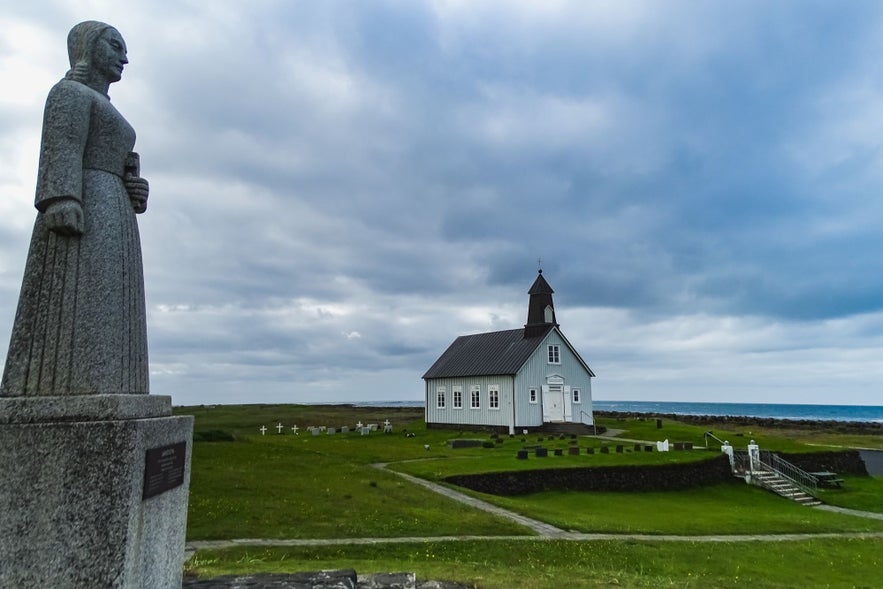
Strandarkirkja is a quaint church known for its votive origins. Near the church, there is a monument to an angel that's said to have miraculously aided sailors caught in a terrifying storm in the ocean nearby. In return, the sailors are said to have built the church in gratitude, and it's thought to bring good luck when invoked in prayer
The interior is also beautiful, with lovely decorations over the wooden interior. The church is a great place to stop and go for a relaxing stroll on a small path leading through the tranquil surroundings, which include a quiet graveyard.
1. The Icelandic Museum of Rock 'n' Roll
 Since Keflavik is the cradle of rock and roll in Iceland, it seems only fitting that The Icelandic Museum of Rock 'n' Roll would be located there. Visitors of this enjoyable museum will get to know the history of pop and rock music in Iceland and the background of world-famous Icelandic musicians, such as Bjork and Sigur Ros, and other Icelandic legends with less international acclaim.
Since Keflavik is the cradle of rock and roll in Iceland, it seems only fitting that The Icelandic Museum of Rock 'n' Roll would be located there. Visitors of this enjoyable museum will get to know the history of pop and rock music in Iceland and the background of world-famous Icelandic musicians, such as Bjork and Sigur Ros, and other Icelandic legends with less international acclaim.
After being handed a tablet upon entry to help navigate the museum, guests are guided through a series of interactive exhibits, with plenty of history and cultural trivia along the way. With plenty of memorabilia relating to the Icelandic music scene and a small cinema showing documentaries detailing the history of pop and rock in Iceland, there is plenty to see.
Be sure not to miss out on the karaoke booth, where you can record videos of yourself jamming out to some Icelandic bangers. You even get to keep the video to immortalize your session and impress your friends and family back home.
4 Lighthouses to Check Out
Strewn about Reykjanes peninsula are many lighthouses that have served the crucial role of guiding sailors to safety in often perilous conditions. While most of them are not accessible, here are a few lighthouses we think make for nice photo stops while exploring Reykjanes.
4. Hopsnesviti Lighthouse

Photo from Wikimedia, Creative Commons, by Diego Delso. No edits made.
Hopnesviti Lighthouse's name is an oddity, as the lighthouse is named after a nearby peninsula and not the one it stands on. This has infuriated Icelandic lighthouse nerds for a long time, but don't let that detract from the lighthouse itself.
Built in 1928, Hopsnesviti Lighthouse stands roughly 28 feet tall (8.7 meters). The lighthouse itself is lovely enough, but the nearby shoreline is the main attraction here, with multiple shipwrecks to see. Fans of the Netflix movie Eurovision Song Contest: The Story of Fire Saga will particularly be delighted to see two pianos used in the movie still on the shore.
3. Stafnesviti Lighthouse
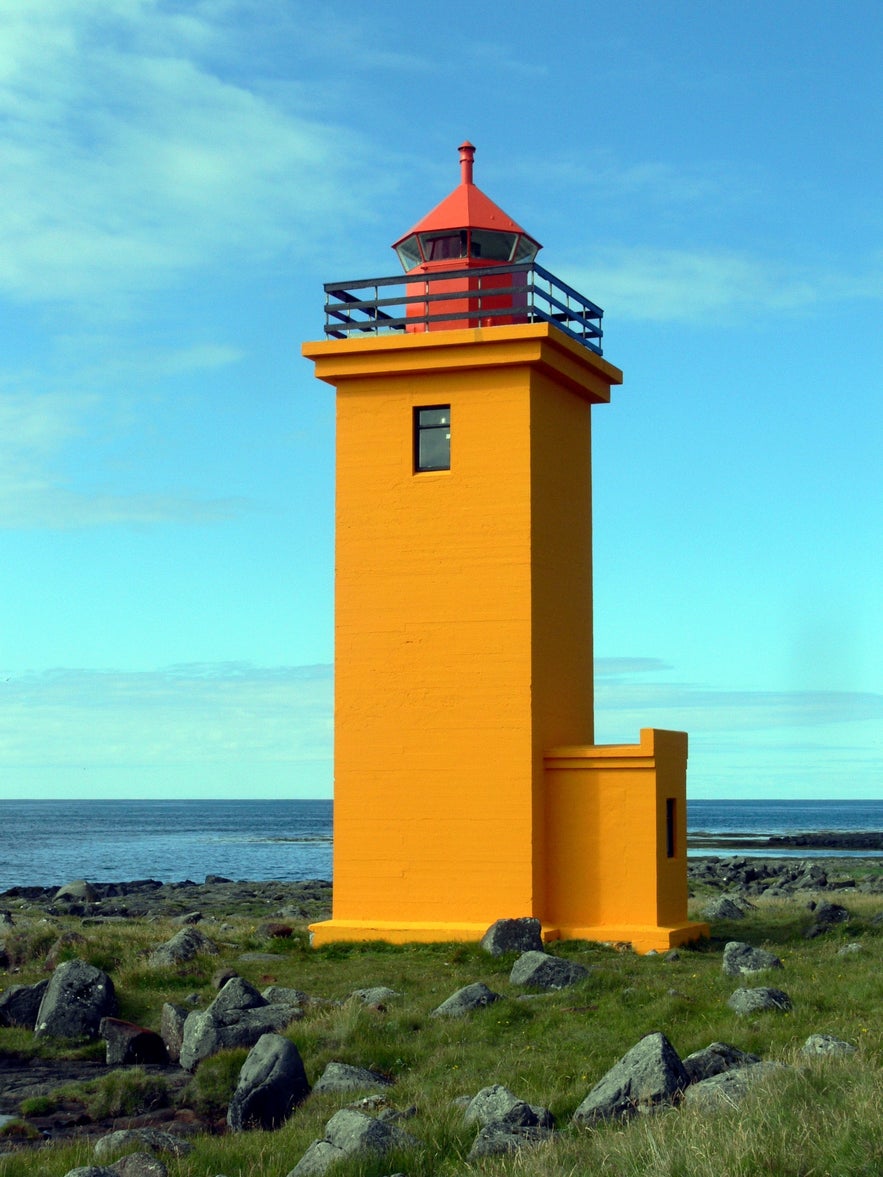
Photo from Wikimedia, Creative Commons, by Christian Bickel. No edits made.
The quirky-looking Stafnesviti lighthouse almost looks like a setpiece from a Wes Anderson flick. Once the site of a mansion, the surroundings and seascape are beautiful but also home to many historical seafaring tragedies.
Stafnesviti Lighthouse stands 26 feet tall (8 meters). It is painted in vibrant yellow and orange colors and is a popular subject for photographers traveling in the area.
2. Gardskagaviti Lighthouse

Photo from Wikimedia, Creative Commons, by Petr Kraumann. No edits made.
Actually, a pair of lighthouses, the older and smaller Gardskagaviti lighthouse, is no longer in use. Once considered one of the best lighthouses in Iceland, the older and shorter lighthouse needed to be replaced as its short size was inadequate in poor weather conditions.
The newer lighthouse was built on Gardskagi in 1944 and stands as the highest lighthouse in Iceland at 91 feet (28 meters) tall. Seeing these lighthouses within a short distance of each other is a good way of seeing how maritime traditions in Iceland have evolved with time.
1. Reykjanesviti Lighthouse
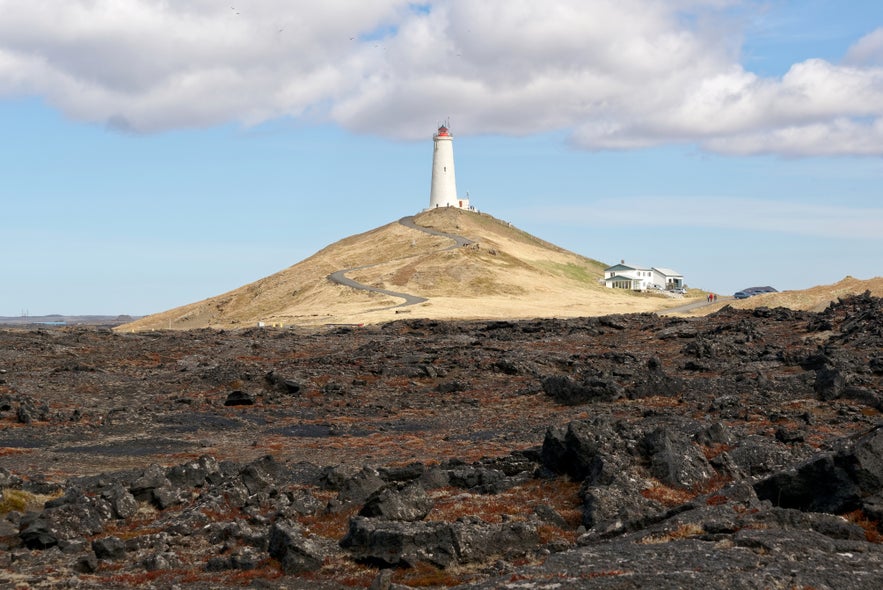
Photo from Wikimedia, Creative Commons, by Jakub Hałun. No edits made.
Located on Reykjanesta is Reykjanesviti, the oldest lighthouse in Iceland. The first lighthouse on the spot was built in 1878 but had to be demolished later on due to the risk of earthquakes. The current lighthouse was built in 1907 and stands 85 feet tall (26 meters).
Due to the erosion of the cliff on which it stands, it is expected that a new building will be needed in the next years. When visiting Reykjanesta, make sure to pay homage to this old guardian who has watched over the rough seas of the peninsula for over a century.
Map of 22 Things to Do in Reykjanes Peninsula
Below, you can find a map of all the sites listed above.
What do you think of our list of things to do in Reykjanes peninsula? Did we miss any of your favorite spots? Do you have a fun story from your travels there? Please let us know in the comments below!





